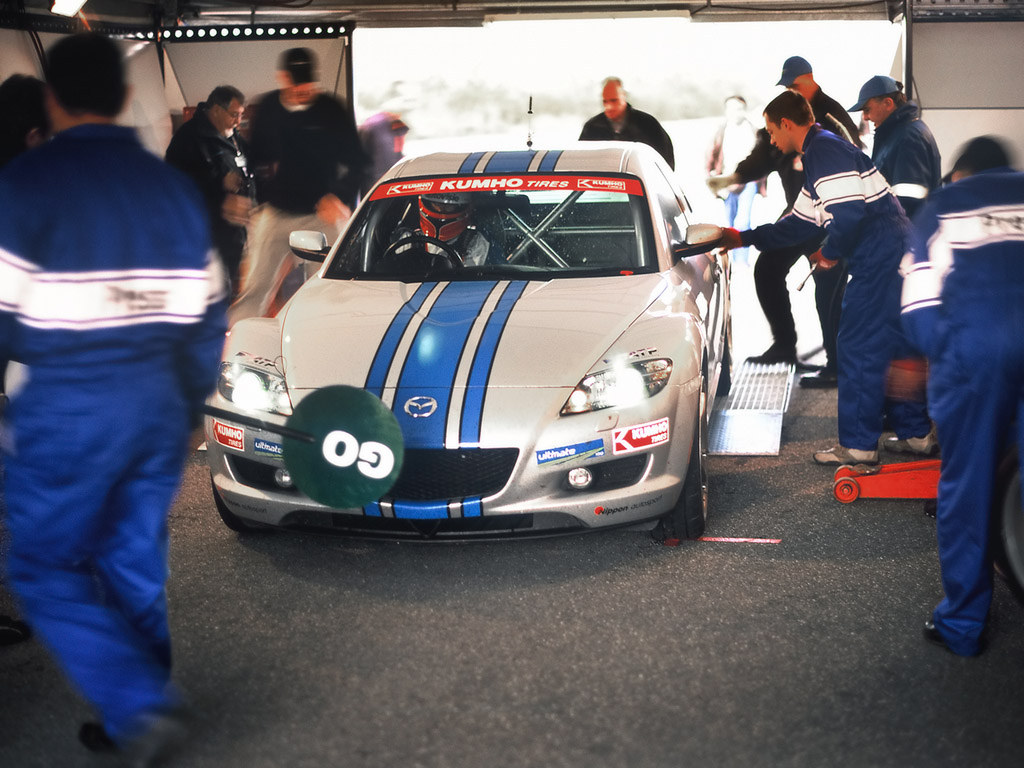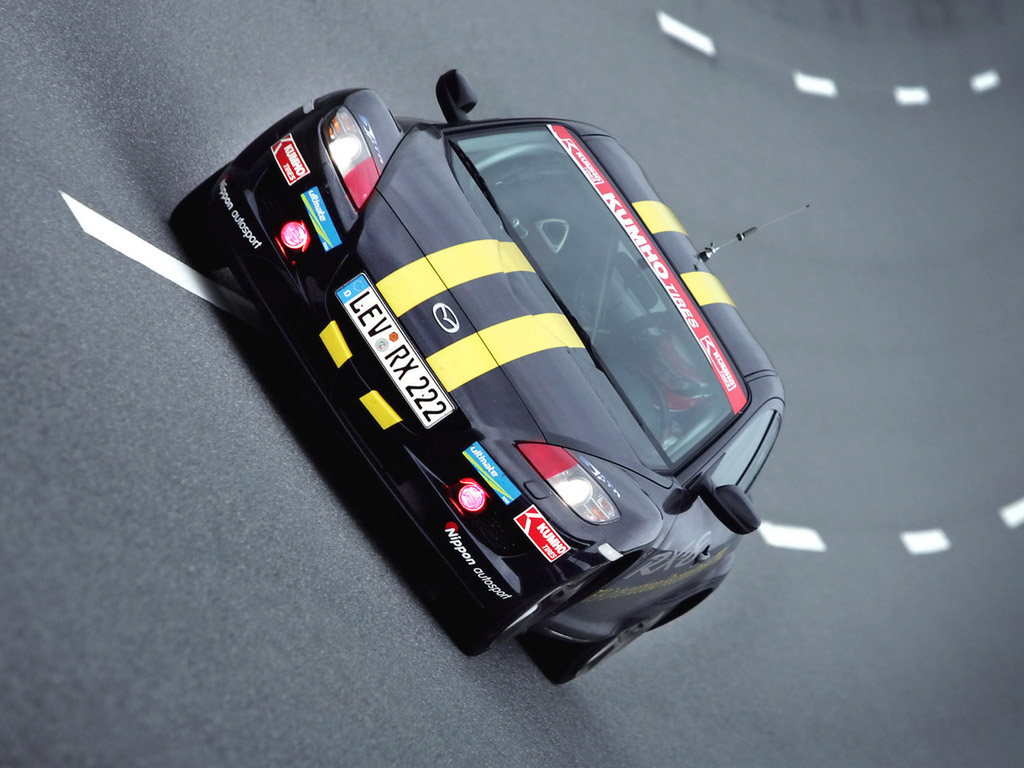|
(from Mazda
Press Release) It is midnight. There
is complete silence on the track and the cold damp darkness has an
inky-black density.
Suddenly the night is sliced open by a pair of electric blue lights
that glare down the straight and head towards the start-finish mark.
The silence is absolute.
The lights draw nearer now, hurtling ahead, and the stillness is
finally ripped apart by the wail of a Mazda RX-8 at full chat,
blasting its way through the night-time air at over 140mph as it
flies down the straight and on towards the next corner.
All eyes flick immediately from the glowing red tail-lights of the
swiftly disappearing car to a flickering television screen on the
trackside that displays the Mazda RX-8's statistics – actual speed,
lap time, lap number and average speed. The engineers, team managers
and other drivers silently punch the air. Mazda is on its way to
setting a new world record.
Well, not just one – make that 40 FIA-recognised world speed
records. At the beginning of this month a 14-strong team of motoring
journalists from 11 European countries, as well as Formula Woman
champion Natasha Firman, put two Mazda RX-8s through the most
gruelling of endurance tests – 24 hours of non-stop maximum speed
around the 7.6mile-long banked circuit at Papenburg test facility,
near Hamburg in the north of Germany.
Under the auspices of the FIA, motorsport's official governing body,
the German motorsport federation DMSB, selected two Mazda RX-8s for
the event. The first was a standard road car and would compete in
Category B for standard production cars. The other entrant was one
of the cars used in this year's successful Formula Woman all-woman
race series, competing in Category A for special vehicles.
Both cars were fitted with a bespoke racing seat, a full roll cage
and fire extinguishers – all mandatory requisites for competition
racing – but their mechanics were left untouched. The FIA even
sealed the engine and gearbox to ensure its mass-produced
authenticity. The race team was also supported by tyre manufacturer
Kumho which supplied dry and wet weather tyres for the event, and
German fuel supplier Aral provided on-site refuelling for the pair
of Mazda RX-8s.
The cars started their ordeal at 12:20pm on Saturday 3 October and,
pausing only to refuel and change drivers, were pushed to their
limits to create 40 new endurance records for naturally aspirated
rotary-powered cars.
Under the hawk-like eyes of Shoji Tokuda, Mazda Motor Europe's chief
engineer who tended to the cars' every needs throughout the 24 hour
period, the pair of RX-8s racked up respective average speeds of
132.250mph in the Group A section, and 134.174mph in Group B, as
well as an array of other time and distance records (see
accompanying tables).
The event also underlines the bulletproof reliability of the Mazda
RX-8. Each car covered a total of 3,174 miles during the 24hour
period without skipping a single revolution of their award-winning
RENESIS twin-rotary engine. Impressive.
The rest of the car was just as fault free – apart from a snapped
boot release cable that caused mass consternation in the pits
because it meant one of the cars would be unable to refuel. But a
bit of inspirational handy work with a mallet and a length of new
cabling soon sorted the problem.
These records better those set by Johnny Herbert, Bertrand Gachot
and Volker Weidler under race conditions during the 1991 Le Mans
24-hour endurance race. Their ferocious 700bhp Mazda 787B racecar
lapped the famous French circuit at an average speed of 127.1mph.
But it’s not just about sitting in a car and driving at top speed
around a big bowl. Papenburg's track is more lozenge-shaped – two
long straights joined by a pair of sweeping, steeply banked curves
at each end.
Despite driving flat out in sixth gear to maintain maximum speed,
further precious seconds can be shaved off a single lap simply by
positioning the car with millimetric accuracy into the entry of the
corner and slingshotting it out the exit. Now, a second here and
there on a lap may not sound much, but over 415 laps, that adds up
to a lot of saved time – and higher speeds.
Driver change-over times were also crucial – witness the flurry of
activity when one of the cars came in to collect a new driver. The
outgoing driver has to enter the pit area as quickly and safely as
possible, position the car for refuelling, kill the engine, release
himself from the four-point harness and then climb out. While the
new driver gets strapped in, the car is refuelled, the oil level and
tyre pressures are painstakingly checked, the headlamps and
windscreen are cleaned and then the go paddle is flashed up and the
race against time starts again. Throughout the entire race every
move on either car was adjudicated by an FIA official to ensure the
attempt met their stringent qualifications.
It's through the long dark night that the drivers really need to be
at the top of their game – as Formula Woman ace Natasha Firman
explains: "It's a lot easier when it's light because you can pick up
your turning reference points and you have a sense of what's around
you. At night though, all you have is what the headlamps pick up. It
makes it difficult to focus on the corner ahead when you can't see
it. And," she admits, "it can feel quite lonely out there because
you feel really isolated from the action."
Nor does it help when it starts to rain – just after midnight the
skies opened, releasing a cold and persistent downpour. A
combination of lights and flags brought the cars into the pits for a
quick tyre change, the Kumho engineers swiftly lowering the car's
tyre pressure to reduce the chance of aquaplaning. But fortune was
smiling on the Mazda team because the rain lasted no longer than an
hour and the cars were soon back up to full pace.
And they maintained this v-max speed for a full 24 hours, crossing
the line just after noon on Sunday 3rd October, with Shoji Tokuda
enthusiastically waving the chequered flag. "There's no tougher test
than this," he said. "We can't think of a better example of the
reliability, strength and power of the Mazda RX-8's RENESIS engine
than a round-the-clock race against time."
|



